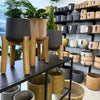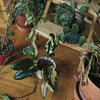Sansevieria or mother-in-law for every household

Sansevieria is a genus of perennial succulent plants belonging to the asparagus family. They originate from Africa, the first recognized specimens were also found in Madagascar, South Asia, India and Sri Lanka. Its difficult-to-pronounce botanical name (But don't worry about it! Pronounce it clearly SAN-SE-VI-É-RIA) is supposedly a memorial to the Italian nobleman Raimondo di Sangro, Prince of Sansevero, who lived in the 18th century. In addition to his hobby of growing indoor and greenhouse plants, he is known as an inventor, writer, soldier and alchemist.
In Czech, these plants are sometimes referred to as tenura , popularly called mother-in-law's tongue (most likely because of its indestructibility, once you get it, you can't get rid of it :-) ). In English, it is called snake plant (because of its pattern on the leaves) or also snake tongue (or mother-in-law's tongue ).
Today, the genus Sansevieria includes about 80 species. That is why many houseplant lovers can make do with just a collection of these diverse species. You can find some of them in our e-shop . Individual species differ in size, shape and color variations. But they have one thing in common. They look magnificent, dramatic and at the same time perfectly minimalist. Perhaps this is the reason for their immense popularity for several centuries. In modern minimalist interiors, they act as a great decoration, but they can be used really anywhere. You will not find such an undemanding plant that is also beneficial to health.
Favorite maid?
Ask anyone, we bet they will all know what mother-in-law's tongue is. They are popular with beginners and experienced growers alike for their unpretentiousness.
Do you remember school hallways? Doctor's waiting rooms? Offices in government offices? You've probably seen typical representatives of sansevieria everywhere. Does that say something about this plant? Yes! It really can adapt to almost any environment , survives even in poor conditions, doesn't suffer from pests and what's more, it will always look good. In fact, it will be happy if you almost forget about it and water it about once a month.
Some people don't like it precisely because the ''mother-in-law'' plants were omnipresent and no one cared for them in common areas, they hadn't been replanted for many years, their long leaves didn't stay upright, they were all covered in dust... Please don't let it get to such proportions at home, these grateful beauties deserve at least minimal care!
How to care for it?
Lighting conditions
Sansevierias are often described as plants for dark rooms with minimal light. They have a special gift for surviving in these conditions and still looking good. They won't mind it in the slightest. But that doesn't mean you have to grow them this way at all costs. If they could choose for themselves, they would definitely choose medium to bright spaces . They will even be happy on a windowsill with direct sunlight. It is also true that the more light they get, the faster they grow .
Dressing
There is one fundamental rule with ansevieria - whenever you want to water them, put down the watering can, release your compulsive need to care for the plant and wait a few more days. After about a week, look at the plant again, try sticking your finger into the substrate and if it is not completely dry , wait again. These plants (or parts of them) will be killed by very few things as reliably as the shelling and subsequent rotting of the roots and leaves.
They retain water in their leaves, so you really don't need to water them often. They like dry soil and you can water them after a few weeks - thoroughly, let the substrate soak in and then leave it alone for 3-4 weeks. This has proven to be the best way to keep them happy. Here we would recommend growing ansevieria in terracotta pots . These are porous and 'breathe'. The substrate dries out faster in them and it rarely happens that the plant rots.
Be even more careful about overwatering in winter and in places where they get little sunlight.
You can occasionally fertilize them in the watering can during the growing season (spring-autumn).
Suitable substrate
We have already mentioned that sansevierias prefer a drier substrate , but we will repeat it here again because it is really important for them. If you want your plant to be happy, plant it in a well- draining substrate . You can achieve this by adding a large amount of perlite or pine bark , which will aerate the substrate. You can also use a special substrate for succulents , but in this case you will have to water a little more often than mentioned, because the water flows through this substrate very quickly and is only minimally retained in it. Or add a portion of peat or coconut fiber to this mix, which have the ability to retain water. When planting sansevieria in a light substrate, such as a substrate for succulents without the above-mentioned additives, it is possible that it will not be well attached there and will wobble. These are long-lived plants and can grow up to two meters in size. Don't forget about good drainage from expanded clay .

Transplanting and propagation
These plants grow relatively slowly, so they don't need to be repotted very often. They will grow faster if they have enough light and you repot them more often into slightly larger pots. But then they can become unnecessarily elongated and their leaves fall off. So don't worry about it and just leave them in the same pot for a few years and wait until the roots start to grow through the drainage holes of the pot.
If you want to propagate your sansevieria, the easiest way to do it is to divide its clumps . Don't be afraid and go for it. Really tear up individual clumps and plant them. It tolerates this type of propagation very well.
Another method of propagation is to let the cut leaves root in water. It will take some time for them to root, but a few of these upright sword-shaped leaves in a vase of water look very decorative. If you remember, change their water, even several times a week. The whole process is accelerated if you add a drop of lignohumate to the water , which stimulates the formation of the root system . However, this is a process that does not always end in 100% success. Unfortunately, sometimes not all the leaves will root, even if they receive the same care. Sometimes it can help if you cut a notch in the shape of an inverted V in the leaves, so that there are two longer parts at the bottom. This will increase the area where the roots should form. This procedure is also recommended for more colorful species, such as Sansevieria laurentii with yellow-lined edges, as this increases the chance that the new shoots will be the same color as the mother plant.
Sansevieria can also be propagated using leaf cuttings in soil (in water, in perlite). Cut one leaf and cut it into 3 to 10 cm sections. However, be careful that you are still able to recognize the growth direction - which side was closer to the roots and which closer to the tip of the leaf. Then stick these sections into a mixture of peat and sand (you can soak the lower part that was closer to the roots in a growth stimulator before that) and water. Cover the bowl or flowerpot in which you planted it with plastic wrap so that the substrate remains slightly moist. Place this propagation station in a bright and sufficiently warm place, try to uncover the plastic wrap every day and 'air' the plants and keep the substrate so that it does not dry out. This style of propagation is a little worse with colorful species, e.g. Sansevieria laurentii , here it is really better to propagate by dividing the clumps and preferably in spring. It happens that the new plants do not have the same color as the mother plant, but remain only green with a pattern.

Cleaning
Many houseplants will appreciate a shower of water once in a while to freshen them up and clean them of dust. You can also give your sansevieria a shower once a year, but these plants, due to their drought-loving nature, will appreciate a wipe with a damp cloth . Do not use leaf polish, they do not like it very much and their interesting pattern on the leaves is beautiful even without it.
Flowering
They say that if you take care of your 'mother-in-law' with love, you will be rewarded with flowers. This is only half true here. It produces flowers unpredictably, but mostly in the summer. They are very decorative with an intoxicating sweet scent. The flower starts out as a small light green stem with lots of stamens, which later unfold, roll up and allow several light green to yellow anthers to stand out. Unfortunately, this beautiful spectacle, often accompanied by the flow of sweet nectar, only lasts a few days and you can cut the flower off after it has completely dried up. Hopefully, it will be successful again soon with another leaf rosette!

Diseases and pests
These plants are also really great when it comes to diseases. They rarely suffer from diseases and pests also avoid them relatively. At most, you may encounter brown dry spots on the edges or in the middle of the leaves, which are an indicator of overwatering . When you see a leaf damaged in this way, cut it off mercilessly and get rid of the leaf so that the rot or fungal disease does not spread to other leaves. Rotting of the base of the leaves or the entire leaf rosette also clearly indicates excess water. Keep watering to a minimum, or try transplanting into a dry substrate.
The plant can sometimes suffer from a lack of light, which is manifested by pale, poorly colored and generally less vital leaves. So move it to a more suitable location and give it enough time to regenerate.
Is she really that perfect?
Yes! And it even has some great abilities. According to NASA, which studied air-purifying plants , sansevierias are great helpers in environments polluted by chemicals . They can largely remove formaldehyde, benzene, trichloroethylene, xylene and toluene from the air. Formaldehyde is highly toxic and carcinogenic, yet it is one of the most widespread poisons in our homes. It is released from the adhesive components of carpets and plywood, foam insulation and is also used in wood preservation.
In addition, they can even produce oxygen not only during the day like most plants, but even at night! This makes them an ideal plant for the bedroom , where they also help break down carbon dioxide and filter the air even during the night. The amount of carbon dioxide has a great influence on the quality of sleep - the lower the CO 2 concentration , the higher the quality of sleep. If something as simple as buying a sansevieria can help us sleep better, it's easy to try, what do you think?
But let's not just praise sansevieria here, there is one thing that is not so positive. And that is the fact that it contains certain chemical compounds that can cause irritation of the digestive tract if ingested . So, to be safe, place it out of reach of pets and try to explain to your children that there are better things to nibble on than the beautiful leaves of sansevieria.
In addition to everything that sansevierias do for our health, they are also a beautiful aesthetic addition. Judge for yourself. In addition to common and relatively well-known species such as Sansevieria trifasciata or Sansevieria laurentii, rare species such as the beautiful Sansevieria trifasciata Grey stripe and the delicately colored Sansevieria moonshine are also available (also in our e-shop) . This genus also includes the interesting Sansevieria cylindrica , which has cylindrical leaves, and Sansevieria masoniana , which is grown in the form of a single planted leaf, which is why we can find it under the names whale/shark's fin plant .
Even my very first plant was S ansevieria trifasciata . In the first grade (at the age of 6!) we were given the task of cutting one of its stems, letting it take root and growing a new plant. My 'tongue', as I affectionately call the plant, did very well, it bloomed several times during my childhood and created countless 'babies'. And a final pearl - I still grow its descendants at home (even after more than 25 years), I gave them to my sister and mother and they still look great. I hereby salute my teacher Mr. Glajce, thanks to whom my love for plants was born! :-)
Betka Lacinová
-
Posted in
Péče o pokojovky




